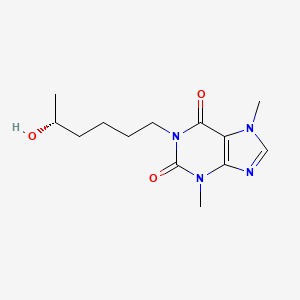

1. 1-(5'-hydroxyhexyl)-3,7-dimethylxanthine
2. 1-(5r-hydroxyhexyl)-3,7-dimethylxanthine
3. 3,7-dimethyl-1-(5-hydroxyhexyl)xanthine
4. A-802710
5. Bl 194
6. Ct-1501r
1. (r)-lisofylline
2. 100324-81-0
3. Protec
4. Ct 1501r
5. Ct-1501r
6. Lisophylline
7. 1-[(5r)-5-hydroxyhexyl]-3,7-dimethylpurine-2,6-dione
8. Lisofylline, (r)-
9. (r)-lisophylline
10. 3,7-dihydro-1-[(5r)-5-hydroxyhexyl]-3,7-dimethyl-1h-purine-2,6-dione
11. 1-((r)-5-hydroxyhexyl)theobromine
12. 1-[(r)-5-hydroxyhexyl]theobromine
13. Lisofilina
14. Lisofyllinum
15. L1f2q2x956
16. (-)-lisofylline
17. 1-(5r-hydroxyhexyl)-3,7-dimethylxanthine
18. Protec (tn)
19. Lisofylline [mi]
20. Lisofylline [inn]
21. Lisofylline (usan/inn)
22. Lisofylline [usan]
23. Chembl1411
24. Schembl39131
25. (r)-lsf
26. Lisofylline [who-dd]
27. Gtpl9225
28. Dtxsid7058709
29. Ct1501r
30. 1h-purine-2,6-dione, 3,7-dihydro-1-(5-hydroxyhexyl)-3,7-dimethyl-, (r)-
31. Chebi:143527
32. Ex-a6722
33. Zinc1887263
34. Akos025394050
35. Db12406
36. Hy-109854a
37. Ncgc00186630-01
38. 1-(5-r-hydroxyhexyl)-3,7-dimethylxanthine
39. Cs-0034091
40. R-1-(5-hydroxyhexyl)-3,7-dimethylxanthine
41. (r)-1-(5-hydroxyhexyl)-3,7-dimethylxanthine
42. D04748
43. J-000102
44. Q15409404
45. 1-[(5r)-5-hydroxyhexyl]-3,7-dimethyl-purine-2,6-dione
46. (r)-1-(5-hydroxyhexyl)-3,7-dimethyl-1h-purine-2,6(3h,7h)-dione
47. 1-[(5r)-5-hydroxyhexyl]-3,7-dimethyl-3,7-dihydro-1h-purine-2,6-dione
48. 1-[(5r)-5-hydroxyhexyl]-3,7-dimethyl-2,3,6,7-tetrahydro-1h-purine-2,6-dione
| Molecular Weight | 280.32 g/mol |
|---|---|
| Molecular Formula | C13H20N4O3 |
| XLogP3 | 0.7 |
| Hydrogen Bond Donor Count | 1 |
| Hydrogen Bond Acceptor Count | 4 |
| Rotatable Bond Count | 5 |
| Exact Mass | 280.15354051 g/mol |
| Monoisotopic Mass | 280.15354051 g/mol |
| Topological Polar Surface Area | 78.7 Ų |
| Heavy Atom Count | 20 |
| Formal Charge | 0 |
| Complexity | 390 |
| Isotope Atom Count | 0 |
| Defined Atom Stereocenter Count | 1 |
| Undefined Atom Stereocenter Count | 0 |
| Defined Bond Stereocenter Count | 0 |
| Undefined Bond Stereocenter Count | 0 |
| Covalently Bonded Unit Count | 1 |
Adjuvants, Immunologic
Substances that augment, stimulate, activate, potentiate, or modulate the immune response at either the cellular or humoral level. The classical agents (Freund's adjuvant, BCG, Corynebacterium parvum, et al.) contain bacterial antigens. Some are endogenous (e.g., histamine, interferon, transfer factor, tuftsin, interleukin-1). Their mode of action is either non-specific, resulting in increased immune responsiveness to a wide variety of antigens, or antigen-specific, i.e., affecting a restricted type of immune response to a narrow group of antigens. The therapeutic efficacy of many biological response modifiers is related to their antigen-specific immunoadjuvanticity. (See all compounds classified as Adjuvants, Immunologic.)
Radiation-Sensitizing Agents
Drugs used to potentiate the effectiveness of radiation therapy in destroying unwanted cells. (See all compounds classified as Radiation-Sensitizing Agents.)
Anti-Inflammatory Agents, Non-Steroidal
Anti-inflammatory agents that are non-steroidal in nature. In addition to anti-inflammatory actions, they have analgesic, antipyretic, and platelet-inhibitory actions. They act by blocking the synthesis of prostaglandins by inhibiting cyclooxygenase, which converts arachidonic acid to cyclic endoperoxides, precursors of prostaglandins. Inhibition of prostaglandin synthesis accounts for their analgesic, antipyretic, and platelet-inhibitory actions; other mechanisms may contribute to their anti-inflammatory effects. (See all compounds classified as Anti-Inflammatory Agents, Non-Steroidal.)
Immunosuppressive Agents
Agents that suppress immune function by one of several mechanisms of action. Classical cytotoxic immunosuppressants act by inhibiting DNA synthesis. Others may act through activation of T-CELLS or by inhibiting the activation of HELPER CELLS. While immunosuppression has been brought about in the past primarily to prevent rejection of transplanted organs, new applications involving mediation of the effects of INTERLEUKINS and other CYTOKINES are emerging. (See all compounds classified as Immunosuppressive Agents.)
Lisofylline has known human metabolites that include lisofylline 4,5-diol and pentoxifylline.
S73 | METXBIODB | Metabolite Reaction Database from BioTransformer | DOI:10.5281/zenodo.4056560